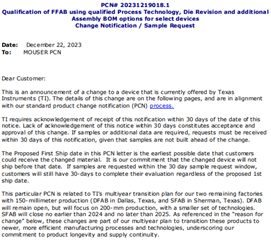Tool/software:
-
Any physical or process-level modifications to the OPA134 device, or
-
Revisions limited to datasheet formatting or test methodology updates.
This thread has been locked.
If you have a related question, please click the "Ask a related question" button in the top right corner. The newly created question will be automatically linked to this question.
Tool/software:
Hi Patil,
In OPA134, the change in the new FAB is specified in the new datasheet. Yes, the physical and FAB process have changed in the latest OPA134, and performance changes are spelled out in the datasheet.

https://www.mouser.com/PCN/Texas_Instruments_PCN20231219018_20231222025145143.pdf
We are aiming to validate continued usage of OPA134UA/2K5 in our system without impacting functionality or performance.
There will be some difference between different FAB process, and the revised differences are specified in the history section of the datasheet. OPA134 is a general purpose op amp and op amp in the new FAB should be equivalent or better performance than the pre-PCN product.
If you are able to compare the functionalities of the pre and the post PCN in OPA134, you will find if there are any differences in your circuit. Typically, I see that an op amp's BW may be increased, the open loop output impedance is slightly different --> this may affect the loop stability somewhat and may require additional compensation, if it is driving capacitive load.
In this part, the previous the trim pin features are removed in the new FAB due to more consistent process; and the change may affect the existing Vos adjustment (if it is used in the circuit). So perform the comparisons will be the best way to see if there are incompatible behaviors in your existing Pass/Fail functionality tests.
I will be happy to take a look at the existing schematic and see if anything needs to be addressed or modified. If you post a "friendship" request via E2E, we are able to communicate via private channel, and you are not posting the schematic in the public forum.
If you have other questions, please let me know.
Best,
Raymond
Thank you for the quick response. I have another query on the same topic.
There is a mismatch between the OPA134 datasheet and PCN 20240902002.1 regarding the input voltage range (in Absolute Maximum Ratings) specification.
In the OPA134 datasheet (Revision History, page 21), the input voltage limit under Absolute Maximum Ratings was changed from (V–) – 0.7V to (V+) + 0.7V to (V–) – 0.5V to (V+) + 0.5V.
However, PCN 20240902002.1 (page 4) states the opposite like from (V–) – 0.5V to (V+) + 0.5V to (V–) – 0.7V to (V+) + 0.7V.
Which version or which specification is correct?
Link for OPA134 datsheet ver.B : https://www.ti.com/lit/ds/symlink/opa2134.pdf?ts=1749048409438
Link for PCN related to datasheet ver. change: https://www.mouser.com/PCN/Texas_Instruments_Datasheet_90_Day_20240902002.1.pdf?srsltid=AfmBOoqD6eqtf5Jdhxw_qMNU-uwN08caIbn0WjsPgH0M_vbGEOPf960y
Waiting for your response.
Hi Ranjeet,
However, PCN 20240902002.1 (page 4) states the opposite like from (V–) – 0.5V to (V+) + 0.5V to (V–) – 0.7V to (V+) + 0.7V.
Please follow the OPA134's datasheet guideline, and the following input voltage ranges are correct. The (V–) – 0.7V to (V+) + 0.7V to (V–) – 0.5V to (V+) + 0.5V is the latest guideline. The (V–) – 0.7V to (V+) + 0.7V ratings were the figures presented in the pre_PCN's datasheet.

FYI, the performance figures in the datasheet have more weight than any other published document at TI. If you have other questions, please let me know.
Best,
Raymond